A Dimension-Reduced Artificial Neural Network Model for the Cell Voltage Consistency Prediction of a Proton Exchange Membrane Fuel Cell Stack
Abstract
:1. Introduction
2. Experiment
3. Model Development
3.1. Artificial Neural Network Model
3.2. Training Procedure
4. Results and Discussion
4.1. Experimental Results and Training Data Preprocessing
4.2. ANN Structure and Model Validation
4.3. Performance Prediction and Analysis
5. Conclusions
- Five grouping strategies for the output values are applied for the ANN model. All of the model structures have a good prediction accuracy, with R2 values greater than 0.999. The predictions under different stack assembly torques fit the experimental results, with margins of error less than 2 mV.
- The ANN model can accurately predict each group’s average voltage under different group strategies. The MSE values of the proposed models are lower than 8 × 10−7. With the reduced output dimension of the model, details of the individual cell voltages are missed, but the distribution trends of the cell voltage distributions are retained.
- The training time decreases as the number of cells in each group decreases. The minimum training time for the five data groups is only six seconds.
- The and range values positively correlate with the load currents under different assembly torques, while the curve slope declines as the model output dimension reduces.
Author Contributions
Funding
Conflicts of Interest
References
- Qiu, D.; Peng, L.; Shen, S.; Lai, X. Analysis of degradation mechanism in unitized regenerative fuel cell under the cyclic operation. Energy Convers. Manag. 2022, 254, 115210. [Google Scholar]
- Yin, C.; Gao, Y.; Li, K.; Wu, D.; Song, Y.; Tang, H. Design and numerical analysis of air-cooled proton exchange membrane fuel cell stack for performance optimization. Energy Convers. Manag. 2021, 245, 114604. [Google Scholar] [CrossRef]
- Wan, Y.; Qiu, D.; Yi, P.; Peng, L.; Lai, X. Design and optimization of gradient wettability pore structure of adaptive PEM fuel cell cathode catalyst layer. Appl. Energy 2022, 312, 118723. [Google Scholar] [CrossRef]
- Zhao, J.; Cai, S.; Luo, X.; Tu, Z. Dynamic characteristics and economic analysis of PEMFC-based CCHP systems with different dehumidification solutions. Int. J. Hydrogen Energy 2022, 47, 11644–11657. [Google Scholar] [CrossRef]
- Yin, C.; Gao, Y.; Li, K.; Song, Y.; Tang, H. Experimental Investigation on Local Behaviors of PEMFC with Segmented Cell. Automot. Innov. 2021, 4, 165–175. [Google Scholar] [CrossRef]
- Bai, X.; Luo, L.; Huang, B.; Huang, Z.; Jian, Q. Flow characteristics analysis for multi-path hydrogen supply within proton exchange membrane fuel cell stack. Appl. Energy 2021, 301, 117468. [Google Scholar] [CrossRef]
- Huang, W.; Jian, Q.; Feng, S.; Huang, Z. A hybrid optimization strategy of electrical efficiency about cooling PEMFC combined with ultra-thin vapor chambers. Energy Convers. Manag. 2022, 254, 115301. [Google Scholar] [CrossRef]
- Bai, X.; Jian, Q.; Huang, B.; Luo, L.; Chen, Y. Hydrogen starvation mitigation strategies during the start-up of proton exchange membrane fuel cell stack. J. Power Sources 2022, 520, 230809. [Google Scholar] [CrossRef]
- Yin, C.; Gao, J.; Wen, X.; Xie, G.; Yang, C.; Fang, H.; Tang, H. In situ investigation of proton exchange membrane fuel cell performance with novel segmented cell design and a two-phase flow model. Energy 2016, 113, 1071–1089. [Google Scholar] [CrossRef]
- Zhao, J.; Tu, Z.; Chan, S.H. In-situ measurement of humidity distribution and its effect on the performance of a proton exchange membrane fuel cell. Energy 2022, 239, 122270. [Google Scholar] [CrossRef]
- Yin, C.; Song, Y.; Liu, M.; Gao, Y.; Li, K.; Qiao, Z.; Tang, H. Investigation of proton exchange membrane fuel cell stack with inversely phased wavy flow field design. Appl. Energy 2022, 305, 117893. [Google Scholar] [CrossRef]
- Gong, C.; Du, Y.; Yu, Y.; Chang, H.; Luo, X.; Tu, Z. Numerical and experimental investigation of enhanced heat transfer radiator through air deflection used in fuel cell vehicles. Int. J. Heat Mass Transf. 2022, 183, 122205. [Google Scholar] [CrossRef]
- Huang, F.; Qiu, D.; Peng, L.; Lai, X. Optimization of entrance geometry and analysis of fluid distribution in manifold for high-power proton exchange membrane fuel cell stacks. Int. J. Hydrogen Energy 2022, 47, 22180–22191. [Google Scholar] [CrossRef]
- Bai, X.; Luo, L.; Huang, B.; Jian, Q.; Cheng, Z. Performance improvement of proton exchange membrane fuel cell stack by dual-path hydrogen supply. Energy 2022, 246, 123297. [Google Scholar] [CrossRef]
- Yang, L.; Cao, C.; Gan, Q.; Pei, H.; Zhang, Q.; Li, P. Revealing failure modes and effect of catalyst layer properties for PEM fuel cell cold start using an agglomerate model. Appl. Energy 2022, 312, 118792. [Google Scholar] [CrossRef]
- Wu, D.; Peng, C.; Yin, C.; Tang, H. Review of System Integration and Control of Proton Exchange Membrane Fuel Cells. Electrochem. Energy Rev. 2020, 3, 466–505. [Google Scholar] [CrossRef]
- Yin, C.; Gao, Y.; Li, T.; Xie, G.; Li, K.; Tang, H. Study of internal multi-parameter distributions of proton exchange membrane fuel cell with segmented cell device and coupled three-dimensional model. Renew. Energy 2020, 147, 650–662. [Google Scholar] [CrossRef]
- Yin, C.; Cao, J.; Tang, Q.; Su, Y.; Wang, R.; Li, K.; Tang, H. Study of internal performance of commercial-size fuel cell stack with 3D multi-physical model and high resolution current mapping. Appl. Energy 2022, 323, 119567. [Google Scholar] [CrossRef]
- Chen, X.; Yang, C.; Sun, Y.; Liu, Q.; Wan, Z.; Kong, X.; Tu, Z.; Wang, X. Water management and structure optimization study of nickel metal foam as flow distributors in proton exchange membrane fuel cell. Appl. Energy 2022, 309, 118448. [Google Scholar] [CrossRef]
- Ahn, S.Y.; Shin, S.J.; Ha, H.Y.; Hong, S.A.; Lee, Y.C.; Lim, T.W.; Oh, I.H. Performance and lifetime analysis of the kW-class PEMFC stack. J. Power Sources 2002, 106, 295–303. [Google Scholar] [CrossRef]
- Barzegari, M.M.; Rahgoshay, S.M.; Mohammadpour, L.; Toghraie, D. Performance prediction and analysis of a dead-end PEMFC stack using data-driven dynamic model. Energy 2019, 188, 116049. [Google Scholar] [CrossRef]
- Dai, C.; Shi, Q.; Chen, W.; Li, Y.; Li, Q. A review of the single cell voltage uniformity in proton exchange membrane fuel cells. Proc. CSEE 2016, 36, 1289–1302. [Google Scholar]
- Zhu, W.H.; Payne, R.U.; Cahela, D.R.; Tatarchuk, B.J. Uniformity analysis at MEA and stack Levels for a Nexa PEM fuel cell system. J. Power Sources 2004, 128, 231–238. [Google Scholar] [CrossRef]
- Futter, G.A.; Latz, A.; Jahnke, T. Physical modeling of chemical membrane degradation in polymer electrolyte membrane fuel cells: Influence of pressure, relative humidity and cell voltage. J. Power Sources 2019, 410, 78–90. [Google Scholar] [CrossRef]
- Chen, K.; Hou, Y.; Jiang, C.; Pan, X.; Hao, D. Experimental investigation on statistical characteristics of cell voltage distribution for a PEMFC stack under dynamic driving cycle. Int. J. Hydrogen Energy 2021, 46, 38469–38481. [Google Scholar] [CrossRef]
- Asensio, F.J.; Martin, J.I.S.; Zamora, I.; Onederra, O. Model for optimal management of the cooling system of a fuel cell-based combined heat and power system for developing optimization control strategies. Appl. Energy 2018, 211, 413–430. [Google Scholar] [CrossRef]
- Laribi, S.; Mammar, K.; Sahli, Y.; Koussa, K. Air supply temperature impact on the PEMFC impedance. J. Energy Storage 2018, 17, 327–335. [Google Scholar] [CrossRef]
- Mohammadi, A.; Djerdir, A.; Steiner, N.Y.; Khaburi, D. Advanced diagnosis based on temperature and current density distributions in a single PEMFC. Int. J. Hydrogen Energy 2015, 40, 15845–15855. [Google Scholar] [CrossRef]
- Zhu, G.Y.; Chen, W.W.; Lu, S.H.; Chen, X.W. Parameter study of high-temperature proton exchange membrane fuel cell using data-driven models. Int. J. Hydrogen Energy 2019, 44, 28958–28967. [Google Scholar] [CrossRef]
- Laribi, S.; Mammar, K.; Sahli, Y.; Koussa, K. Analysis and diagnosis of PEM fuel cell failure modes (flooding & drying) across the physical parameters of electrochemical impedance model: Using neural networks method. Sustain. Energy Technol. Assess. 2019, 34, 35–42. [Google Scholar]
- Tian, Y.; Zou, Q.; Han, J. Data-Driven Fault Diagnosis for Automotive PEMFC Systems Based on the Steady-State Identification. Energies 2021, 14, 1918. [Google Scholar] [CrossRef]
- Nanadegani, F.S.; Lay, E.N.; Iranzo, A.; Salva, J.A.; Sunden, B. On neural network modeling to maximize the power output of PEMFCs. Electrochim. Acta 2020, 348, 136345. [Google Scholar] [CrossRef]
- Wilberforce, T.; Olabi, A.G. Proton exchange membrane fuel cell performance prediction using artificial neural network. Int. J. Hydrogen Energy 2021, 46, 6037–6050. [Google Scholar] [CrossRef]
- Bhagavatula, Y.S.; Bhagavatula, M.T.; Dhathathreyan, K.S. Application of artificial neural network in performance prediction of PEM fuel cell. Int. J. Energy Res. 2012, 36, 1215–1225. [Google Scholar] [CrossRef]
- Han, I.-S.; Park, S.-K.; Chung, C.-B. Modeling and operation optimization of a proton exchange membrane fuel cell system for maximum efficiency. Energy Convers. Manag. 2016, 113, 52–65. [Google Scholar] [CrossRef]
- Yang, Z.; Wang, B.; Sheng, X.; Wang, Y.; Ren, Q.; He, S.; Xuan, J.; Jiao, K. An Artificial Intelligence Solution for Predicting Short-Term Degradation Behaviors of Proton Exchange Membrane Fuel Cell. Appl. Sci. 2021, 11, 6348. [Google Scholar] [CrossRef]
- Long, B.; Wu, K.; Li, P.; Li, M. A novel remaining useful life prediction method for hydrogen fuel cells based on the gated recurrent unit neural network. Appl. Sci. 2022, 12, 432. [Google Scholar] [CrossRef]
- Wilberforce, T.; Biswas, M. A study into Proton Exchange Membrane Fuel Cell power and voltage prediction using Artificial Neural Network. Energy Rep. 2022, 8, 12843–12852. [Google Scholar] [CrossRef]
- Wilberforce, T.; Biswas, M.; Omran, A. Power and Voltage Modelling of a Proton-Exchange Membrane Fuel Cell Using Artificial Neural Networks. Energies 2022, 15, 5587. [Google Scholar] [CrossRef]
- Musharavati, F. Four dimensional bio-inspired optimization approach with artificial intelligence for proton exchange membrane fuel cell. Int. J. Energy Res. 2022. [Google Scholar] [CrossRef]
- Su, Y.; Yin, C.; Hua, S.; Wang, R.; Tang, H. Study of cell voltage uniformity of proton exchange membrane fuel cell stack with an optimized artificial neural network model. Int. J. Hydrogen Energy 2022, 47, 29037–29052. [Google Scholar] [CrossRef]
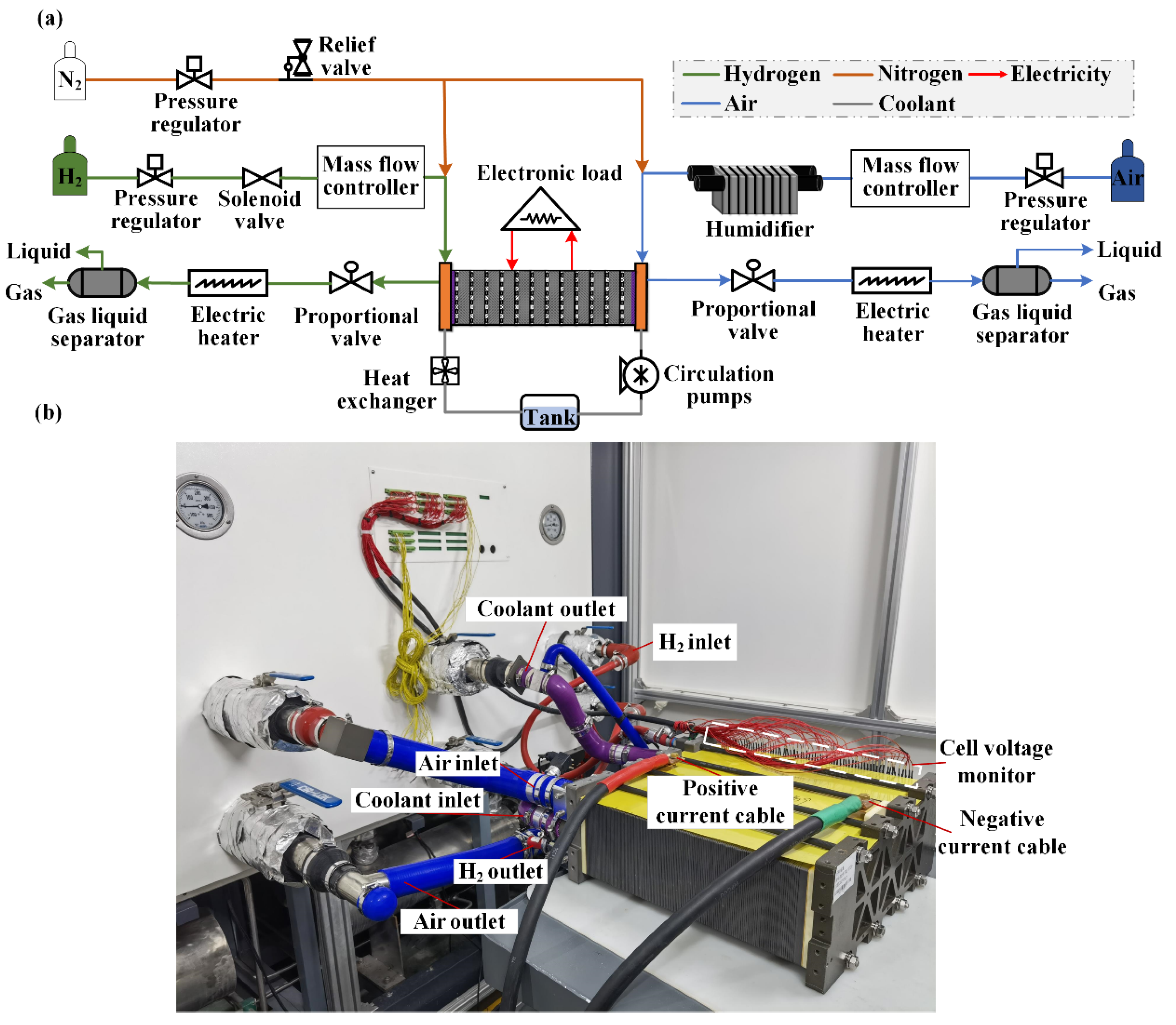
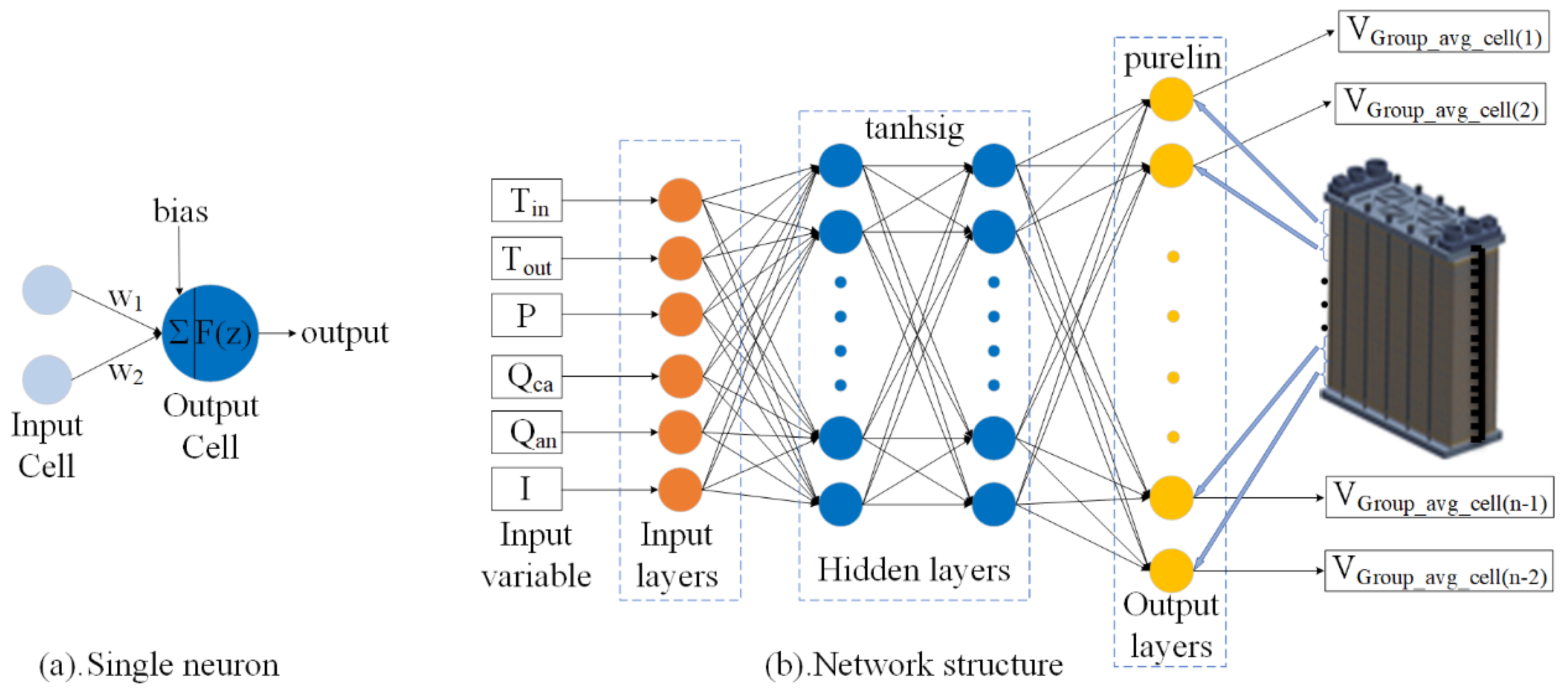

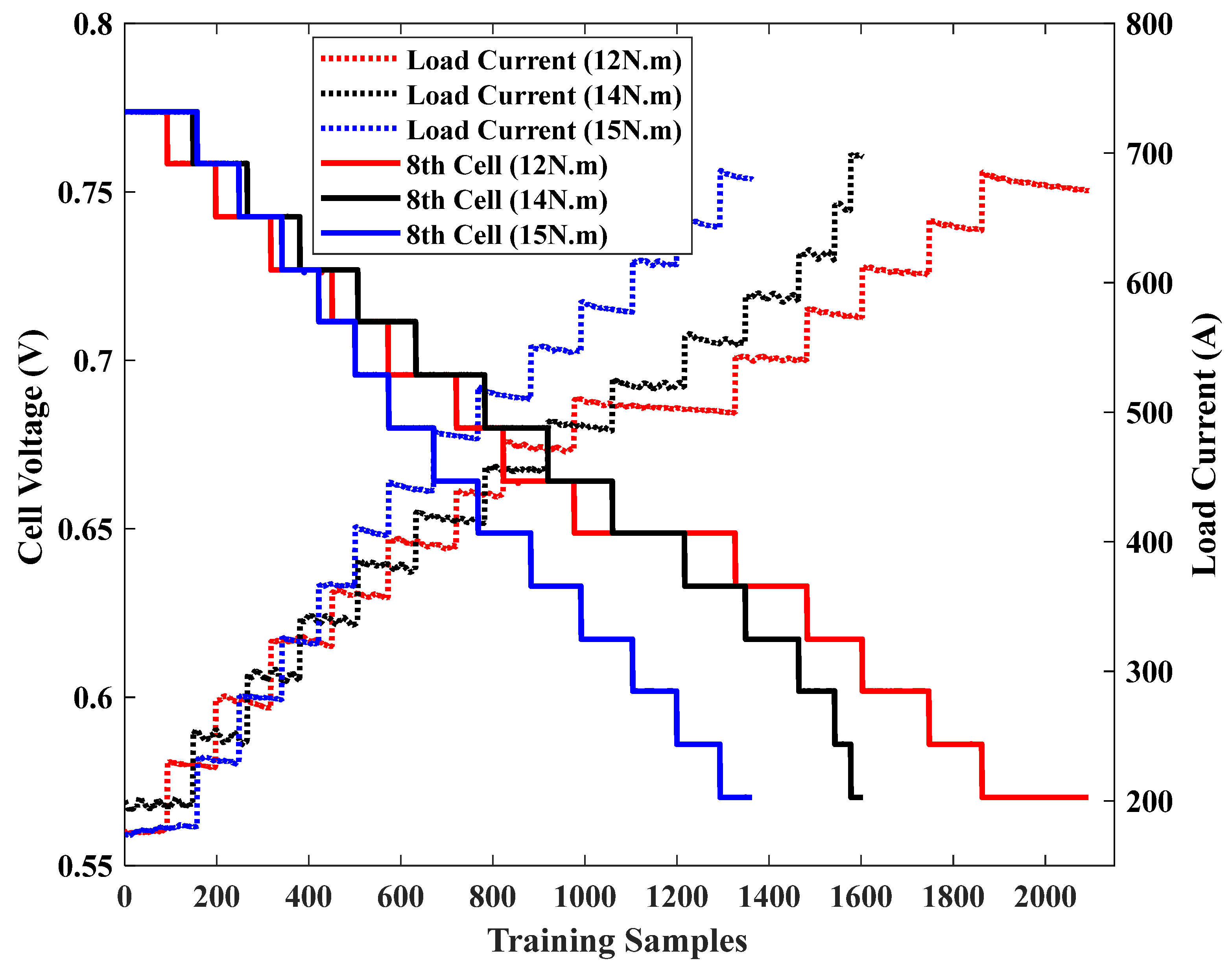
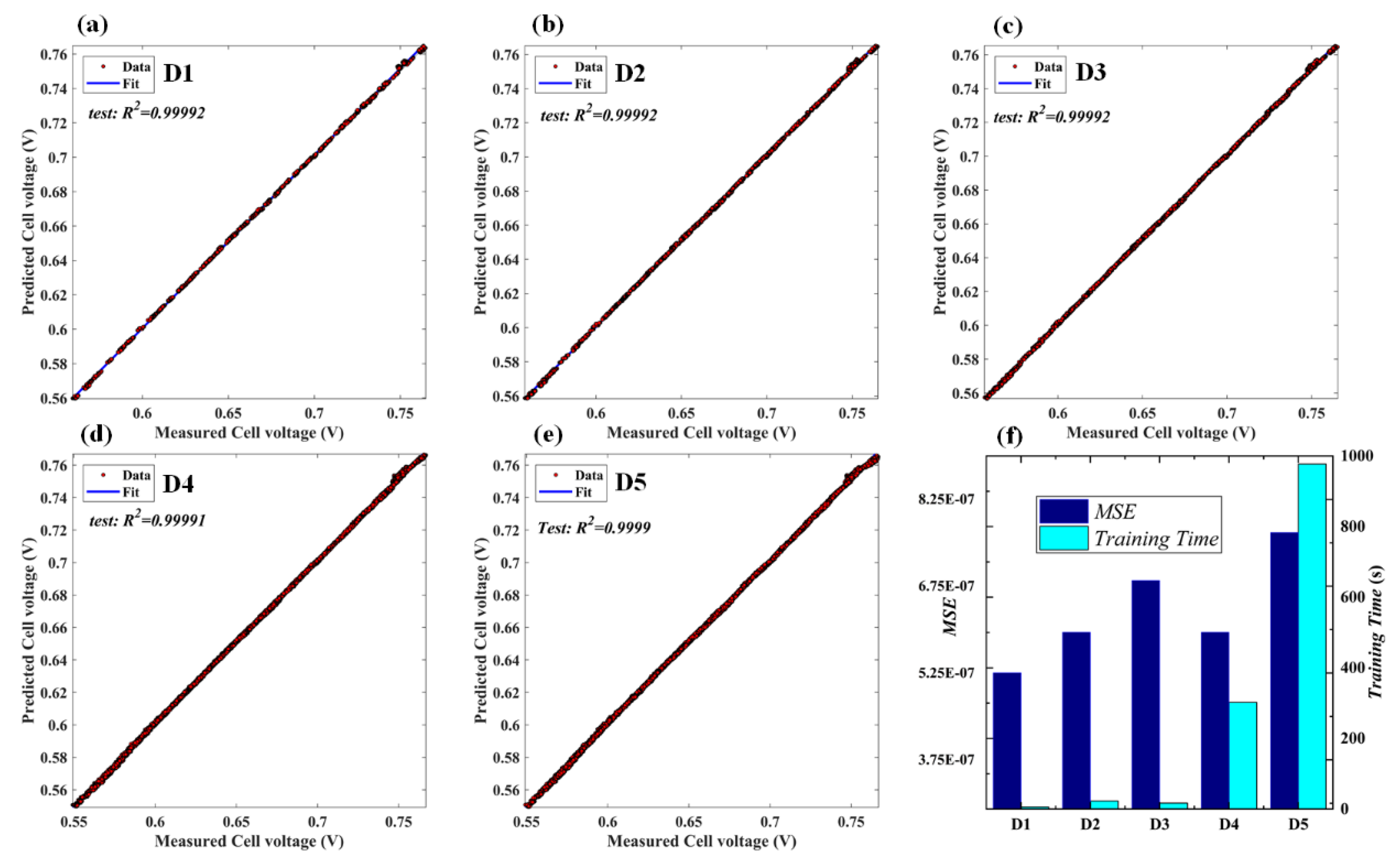
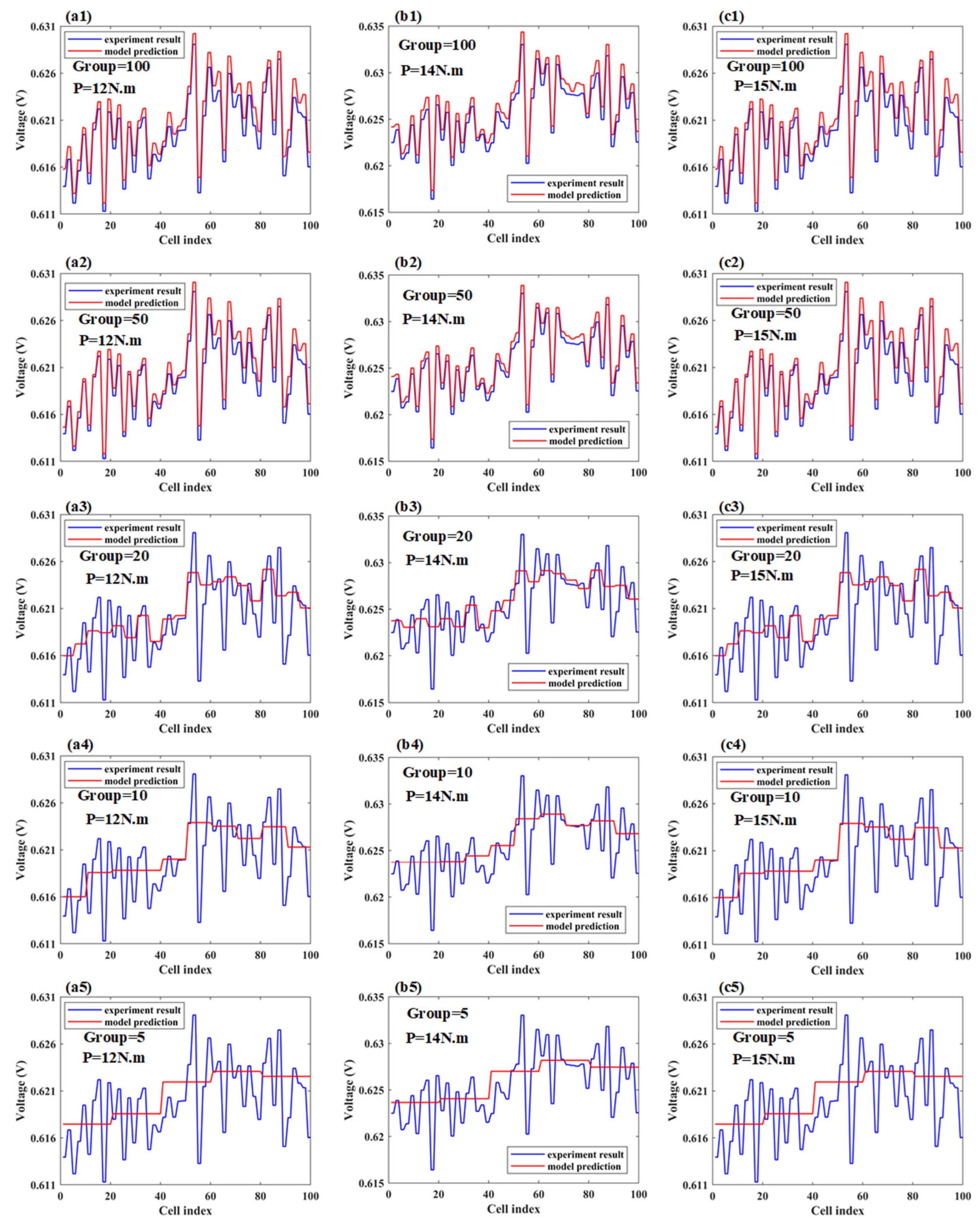


| Parameter | Symbol | Value |
|---|---|---|
| Load Current | I | 203 A~730.8 A |
| Stoichiometric Ratio of Hydrogen | λa | 1.3 |
| Stoichiometric Ratio of Air | λc | 2.0 |
| Assembling Torque | P | 12 N.m, 14 N.m, 15 N.m |
| Coolant Inlet Temperature | Tin | 72~75.5 °C |
| Coolant Outlet Temperature | Tout | 74~81 °C |
| ANN Structure | R2 | MSE | Training Time | |
|---|---|---|---|---|
| D1 | 6-8-5-5 | 0.99992 | 5.2523 × 10−7 | 6 s |
| D2 | 6-8-5-10 | 0.99992 | 5.9548 × 10−7 | 23 s |
| D3 | 6-8-5-20 | 0.99992 | 6.8463 × 10−7 | 17 s |
| D4 | 6-8-5-50 | 0.99991 | 6.3335 × 10−7 | 302 s |
| D5 | 6-8-5-100 | 0.99990 | 7.6788 × 10−7 | 977 s |
Publisher’s Note: MDPI stays neutral with regard to jurisdictional claims in published maps and institutional affiliations. |
© 2022 by the authors. Licensee MDPI, Basel, Switzerland. This article is an open access article distributed under the terms and conditions of the Creative Commons Attribution (CC BY) license (https://creativecommons.org/licenses/by/4.0/).
Share and Cite
Cao, J.; Yin, C.; Feng, Y.; Su, Y.; Lu, P.; Tang, H. A Dimension-Reduced Artificial Neural Network Model for the Cell Voltage Consistency Prediction of a Proton Exchange Membrane Fuel Cell Stack. Appl. Sci. 2022, 12, 11602. https://doi.org/10.3390/app122211602
Cao J, Yin C, Feng Y, Su Y, Lu P, Tang H. A Dimension-Reduced Artificial Neural Network Model for the Cell Voltage Consistency Prediction of a Proton Exchange Membrane Fuel Cell Stack. Applied Sciences. 2022; 12(22):11602. https://doi.org/10.3390/app122211602
Chicago/Turabian StyleCao, Jishen, Cong Yin, Yulun Feng, Yanghuai Su, Pengfei Lu, and Hao Tang. 2022. "A Dimension-Reduced Artificial Neural Network Model for the Cell Voltage Consistency Prediction of a Proton Exchange Membrane Fuel Cell Stack" Applied Sciences 12, no. 22: 11602. https://doi.org/10.3390/app122211602





